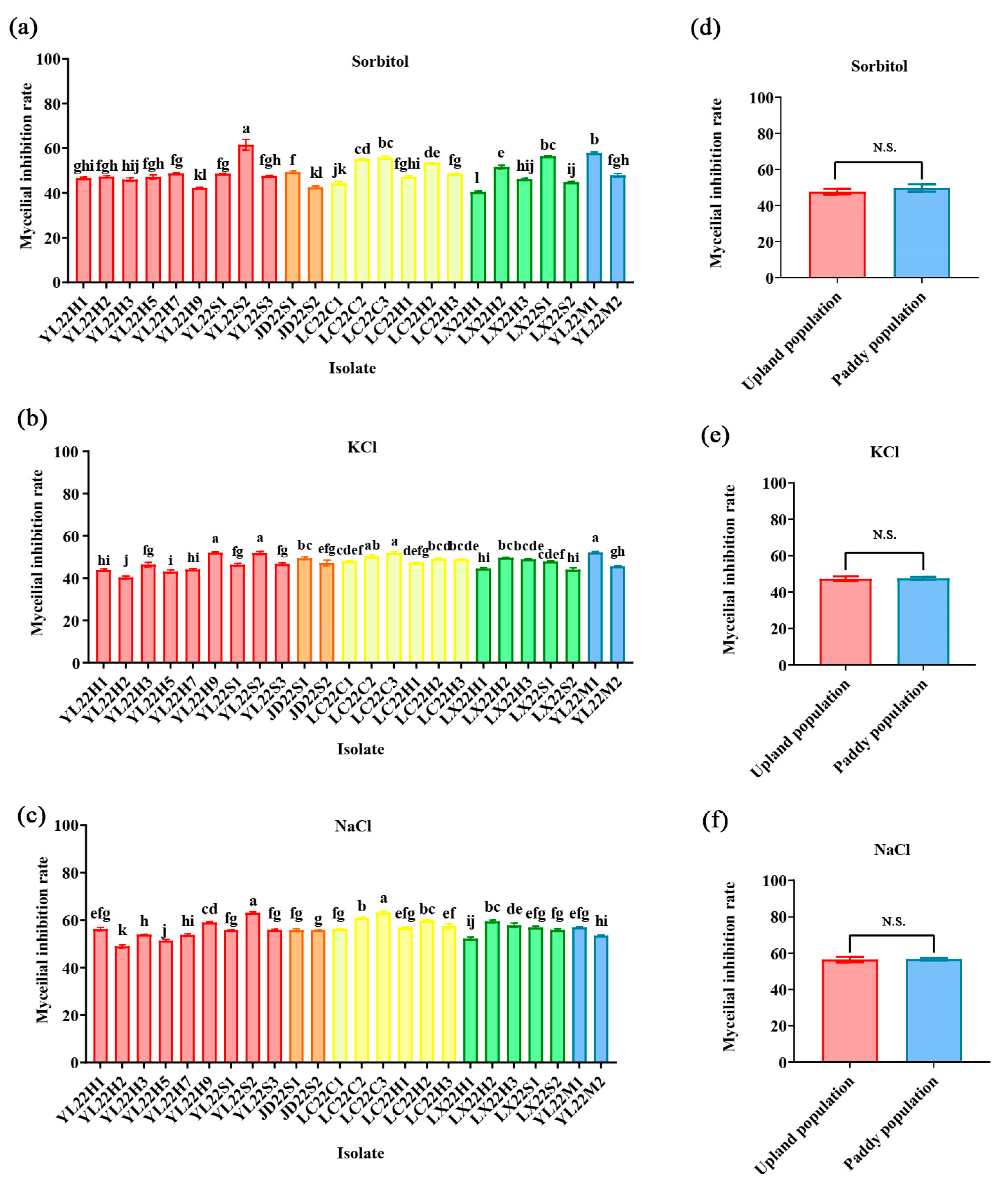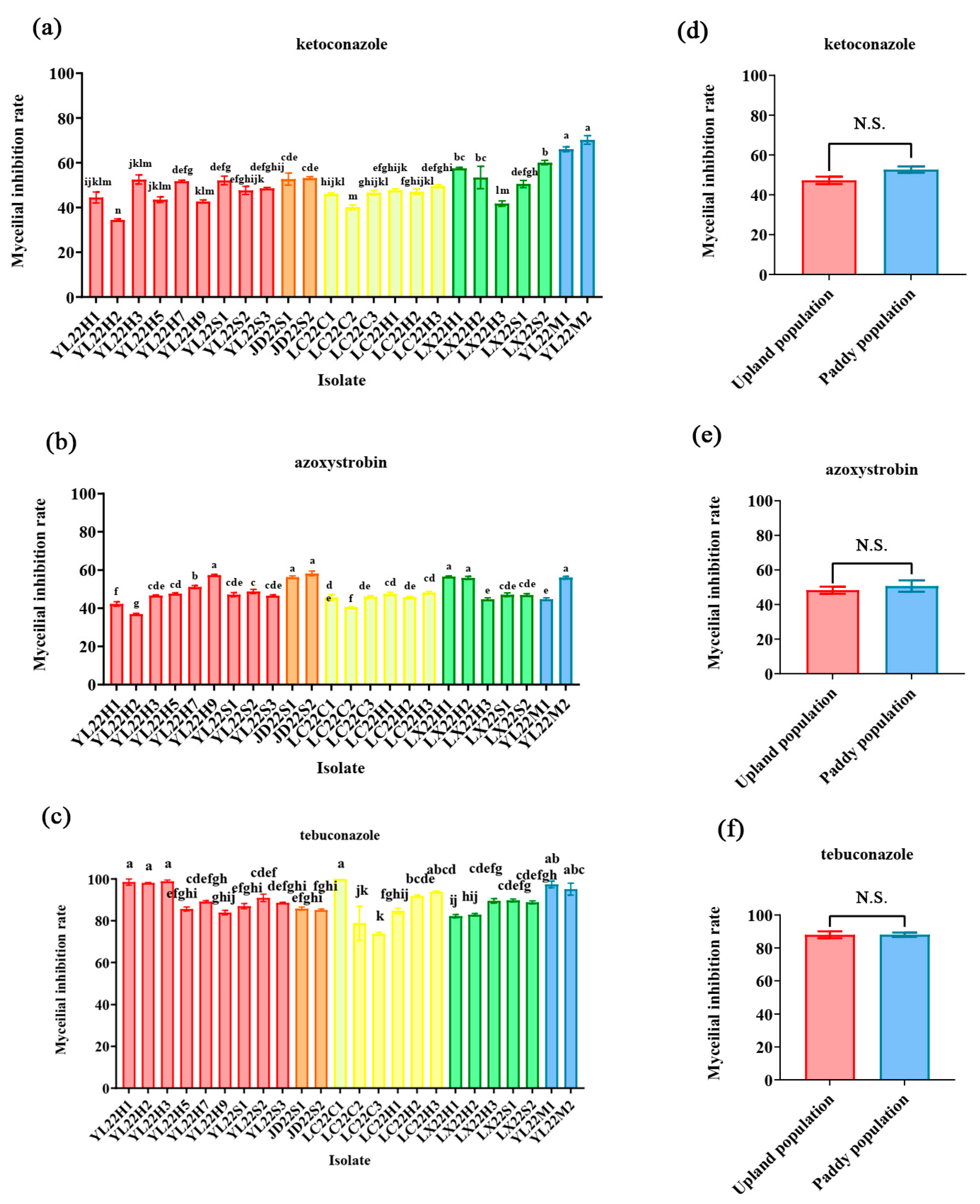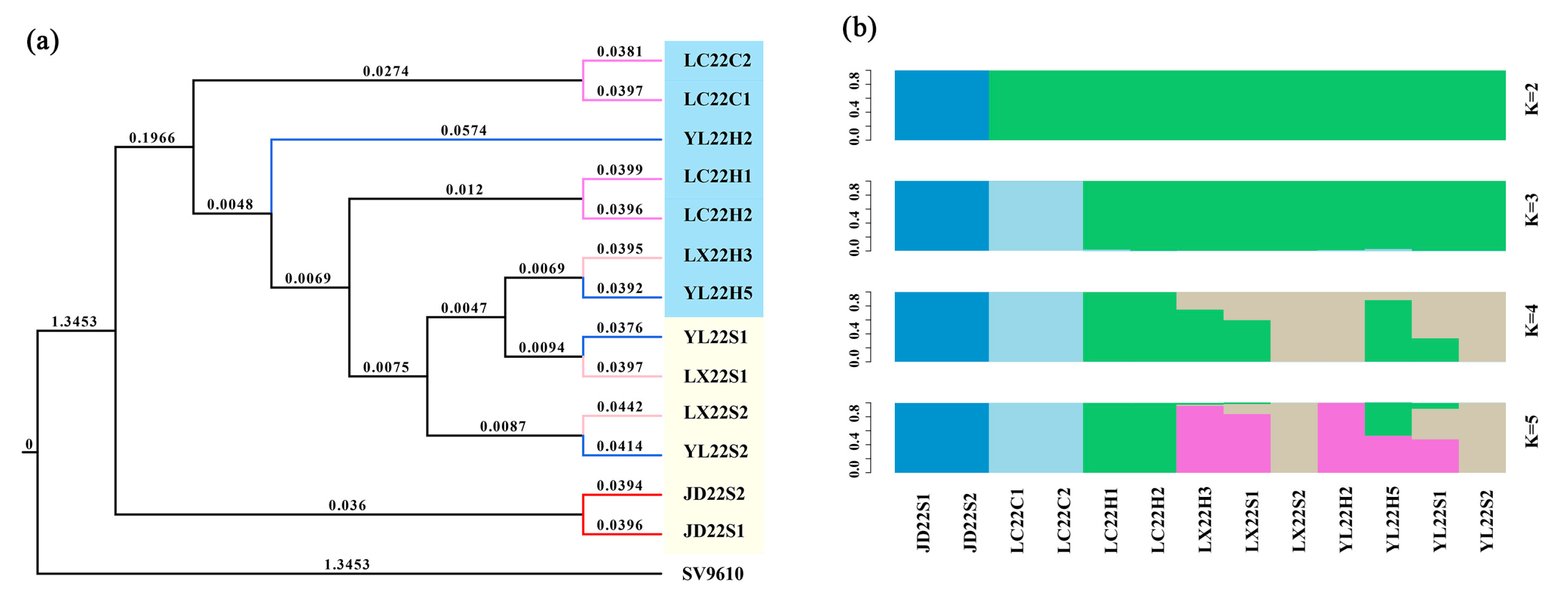Pathogenicity and Genetic Variations in Magnaporthe oryzae Isolates from One Rice Variety Planting in Paddy and Upland Fields
Abstract
1. Introduction
2. Materials and Methods
2.1. Collection of Rice Blast Isolates
2.2. Rice Varieties
2.3. Pathogenicity Test
2.4. Fungicide and Osmotic Stress-Inducer Treatment
2.5. Genome Sequencing
2.6. Single Nucleotide Polymorphism Analysis
2.7. Statistical Analyses
3. Results
3.1. Pathogenicity of M. oryzae Isolates from Paddy and Upland Fields
3.2. Resistance Assessment of Different Rice Varieties
3.3. Inhibitory Tests of Osmotic Stress and Fungicide in 24 Isolates
3.4. Genome Sequencing and SNP Calling of 15 Representative Isolates
3.5. Polygenetic Analyses of 13 Sequenced Isolates
3.6. Functional Analyses of Planting-Filed Specific Genes Based on SNPs
4. Discussion
5. Conclusions
Author Contributions
Funding
Data Availability Statement
Acknowledgments
Conflicts of Interest
References
- Zhang, Q. Strategies for developing green super rice. Proc. Natl. Acad. Sci. USA 2007, 104, 16402–16409. [Google Scholar] [CrossRef] [PubMed]
- Xia, H.; Zhang, X.; Liu, Y.; Bi, J.; Ma, X.; Zhang, A.; Liu, H.; Chen, L.; Zhou, S.; Gao, H. Blue revolution for food security under carbon neutrality: A case from the water-saving and drought-resistance rice. Mol. Plant 2022, 15, 1401–1404. [Google Scholar] [CrossRef]
- Luo, L. Breeding for water-saving and drought-resistance rice (wdr) in china. J. Exp. Bot. 2010, 61, 3509–3517. [Google Scholar] [CrossRef] [PubMed]
- Xia, H.; Luo, Z.; Xiong, J.; Ma, X.; Lou, Q.; Wei, H.; Qiu, J.; Yang, H.; Liu, G.; Fan, L. Bi-directional selection in upland rice leads to its adaptive differentiation from lowland rice in drought resistance and productivity. Mol. Plant 2019, 12, 170–184. [Google Scholar] [CrossRef] [PubMed]
- Dean, R.; Van Kan, J.A.; Pretorius, Z.A.; Hammond-Kosack, K.E.; Di Pietro, A.; Spanu, P.D.; Rudd, J.J.; Dickman, M.; Kahmann, R.; Ellis, J. The top 10 fungal pathogens in molecular plant pathology. Mol. Plant Pathol. 2012, 13, 414–430. [Google Scholar] [CrossRef]
- Gladieux, P.; Ravel, S.; Rieux, A.; Cros-Arteil, S.; Adreit, H.; Milazzo, J.; Thierry, M.; Fournier, E.; Terauchi, R.; Tharreau, D. Coexistence of multiple endemic and pandemic lineages of the rice blast pathogen. mBio 2018, 9, e01806–e01817. [Google Scholar] [CrossRef]
- Thierry, M.; Charriat, F.; Milazzo, J.; Adreit, H.; Ravel, S.; Cros-Arteil, S.; Borron, S.; Sella, V.; Kroj, T.; Ioos, R. Maintenance of divergent lineages of the rice blast fungus Pyricularia oryzae through niche separation, loss of sex and post-mating genetic incompatibilities. PLoS Pathog. 2022, 18, e1010687. [Google Scholar]
- Saleh, D.; Milazzo, J.; Adreit, H.; Fournier, E.; Tharreau, D. South-east asia is the center of origin, diversity and dispersion of the rice blast fungus, Magnaporthe oryzae. New Phytol. 2014, 201, 1440–1456. [Google Scholar] [CrossRef]
- Hayashi, N.; Fukuta, Y. Proposal for a new international system of differentiating races of blast (Pyricularia oryzae Cavara) by using LTH monogenic lines in rice (Oryza sativa L.). JIRCAS Work. Rep. 2009, 63, 11–15. [Google Scholar]
- Kadeawi, S.; Nasution, A.; Hairmansis, A.; Telebanco-Yanoria, M.J.; Obara, M.; Hayashi, N.; Fukuta, Y. Pathogenicity of isolates of the rice blast pathogen (Pyricularia oryzae) from Indonesia. Plant Dis. 2021, 105, 675–683. [Google Scholar] [CrossRef]
- Xin, X.-F.; Nomura, K.; Aung, K.; Velásquez, A.C.; Yao, J.; Boutrot, F.; Chang, J.H.; Zipfel, C.; He, S.Y. Bacteria establish an aqueous living space in plants crucial for virulence. Nature 2016, 539, 524–529. [Google Scholar] [CrossRef]
- Schwartz, A.R.; Morbitzer, R.; Lahaye, T.; Staskawicz, B.J. TALE-induced bHLH transcription factors that activate a pectate lyase contribute to water soaking in bacterial spot of tomato. Proc. Natl. Acad. Sci. USA 2017, 114, E897–E903. [Google Scholar] [CrossRef]
- Qiu, J.; Liu, Z.; Xie, J.; Lan, B.; Shen, Z.; Shi, H.; Lin, F.; Shen, X.; Kou, Y. Dual impact of ambient humidity on the virulence of Magnaporthe oryzae and basal resistance in rice. Plant Cell Environ. 2022, 45, 3399–3411. [Google Scholar] [CrossRef] [PubMed]
- Asibi, A.E.; Chai, Q.; Coulter, J.A. Rice blast: A disease with implications for global food security. Agronomy 2019, 9, 451. [Google Scholar] [CrossRef]
- Wilson, R.A.; Talbot, N.J. Under pressure: Investigating the biology of plant infection by Magnaporthe oryzae. Nat. Rev. Microbiol. 2009, 7, 185–195. [Google Scholar] [CrossRef] [PubMed]
- Gladieux, P.; Condon, B.; Ravel, S.; Soanes, D.; Maciel, J.L.N.; Nhani Jr, A.; Chen, L.; Terauchi, R.; Lebrun, M.-H.; Tharreau, D. Gene flow between divergent cereal-and grass-specific lineages of the rice blast fungus Magnaporthe oryzae. mBio 2018, 9, e01219-17. [Google Scholar] [CrossRef]
- Islam, M.T.; Gupta, D.R.; Hossain, A.; Roy, K.K.; He, X.; Kabir, M.R.; Singh, P.K.; Khan, M.; Rahman, A.; Rahman, M. Wheat blast: A new threat to food security. Phytopathol. Res. 2020, 2, 28. [Google Scholar] [CrossRef]
- Wu, Q.; Wang, Y.; Liu, L.-N.; Shi, K.; Li, C.-Y. Comparative genomics and gene pool analysis reveal the decrease of genome diversity and gene number in rice blast fungi by stable adaption with rice. J. Fungi 2022, 8, 5. [Google Scholar] [CrossRef]
- Shizhen, W.; Jiaoyu, W.; Zhen, Z.; Zhongna, H.; Xueming, Z.; Rongyao, C.; Haiping, Q.; Yanli, W.; Fucheng, L.; Guochang, S. The risk of wheat blast in rice–wheat co-planting regions in china: Moo strains of Pyricularia oryzae cause typical symptom and host reaction on both wheat leaves and spikes. Phytopathology 2021, 111, 1393–1400. [Google Scholar] [CrossRef]
- Zhong, Z.; Norvienyeku, J.; Chen, M.; Bao, J.; Lin, L.; Chen, L.; Lin, Y.; Wu, X.; Cai, Z.; Zhang, Q. Directional selection from host plants is a major force driving host specificity in Magnaporthe species. Sci. Rep. 2016, 6, 25591. [Google Scholar] [CrossRef]
- Ali, S.; Gladieux, P.; Ravel, S.; Adreit, H.; Meusnier, I.; Milazzo, J.; Cros-Arteil, S.; Bonnot, F.; Jin, B.; Dumartinet, T. Evolution of the rice blast pathogen on spatially structured rice landraces maintains multiple generalist fungal lineages. Mol. Ecol. 2023, ahead of print. [Google Scholar] [CrossRef]
- Liao, J.; Huang, H.; Meusnier, I.; Adreit, H.; Ducasse, A.; Bonnot, F.; Pan, L.; He, X.; Kroj, T.; Fournier, E. Pathogen effectors and plant immunity determine specialization of the blast fungus to rice subspecies. Elife 2016, 5, e19377. [Google Scholar] [CrossRef] [PubMed]





| Isolates | Hosts | Collected Area | Field Types |
|---|---|---|---|
| YL22H1 | Dianheyou 615 | Yiliang | Upland field |
| YL22H2 | Dianheyou 615 | Yiliang | Upland field |
| YL22H3 | Dianheyou 615 | Yiliang | Upland field |
| YL22H5 | Dianheyou 615 | Yiliang | Upland field |
| YL22H7 | Dianheyou 615 | Yiliang | Upland field |
| YL22H9 | Dianheyou 615 | Yiliang | Upland field |
| YL22S1 | Dianheyou 615 | Yiliang | Paddy field |
| YL22S2 | Dianheyou 615 | Yiliang | Paddy field |
| YL22S3 | Dianheyou 615 | Yiliang | Paddy field |
| YL22M1 | D. sanguinalis | Yiliang | Upland field |
| YL22M2 | D. sanguinalis | Yiliang | Upland field |
| JD22S1 | Dianheyou 615 | Jingdong | Paddy field |
| JD22S2 | Dianheyou 615 | Jingdong | Paddy field |
| LC22H1 | Dianheyou 615 | Lancang | Upland field |
| LC22H2 | Dianheyou 615 | Lancang | Upland field |
| LC22H3 | Dianheyou 615 | Lancang | Upland field |
| LC22C1 | Conventional rice | Lancang | Upland field |
| LC22C2 | Conventional rice | Lancang | Upland field |
| LC22C3 | Conventional rice | Lancang | Upland field |
| LX22H1 | Dianheyou 615 | Linxiang | Upland field |
| LX22H2 | Dianheyou 615 | Linxiang | Upland field |
| LX22H3 | Dianheyou 615 | Linxiang | Upland field |
| LX22S1 | Dianheyou 615 | Linxiang | Paddy field |
| LX22S2 | Dianheyou 615 | Linxiang | Paddy field |
| Isolates | No. of Susceptible Rices | Pathogenicity Frequency | Pathogenicity Type |
|---|---|---|---|
| YL22S1 | 32 | 88.89% | Highest pathogenicity |
| YL22S2 | 36 | 100.00% | Highest pathogenicity |
| YL22S3 | 36 | 100.00% | Highest pathogenicity |
| YL22H1 | 36 | 100.00% | Highest pathogenicity |
| YL22H2 | 34 | 94.44% | Highest pathogenicity |
| YL22H3 | 32 | 88.89% | Highest pathogenicity |
| YL22H5 | 33 | 91.67% | Highest pathogenicity |
| YL22H7 | 35 | 97.22% | Highest pathogenicity |
| YL22H9 | 34 | 94.44% | Highest pathogenicity |
| JD22S1 | 33 | 91.67% | Highest pathogenicity |
| JD22S2 | 26 | 72.22% | Highest pathogenicity |
| LC22C1 | 25 | 69.44% | High pathogenicity |
| LC22C2 | 25 | 69.44% | High pathogenicity |
| LC22C3 | 27 | 75.00% | Highest pathogenicity |
| LC22H1 | 29 | 80.56% | Highest pathogenicity |
| LC22H2 | 30 | 83.33% | Highest pathogenicity |
| LC22H3 | 31 | 86.11% | Highest pathogenicity |
| LX22H1 | 22 | 61.11% | High pathogenicity |
| LX22H2 | 24 | 66.67% | High pathogenicity |
| LX22H3 | 21 | 58.33% | High pathogenicity |
| LX22S1 | 29 | 80.56% | Highest pathogenicity |
| LX22S2 | 30 | 83.33% | Highest pathogenicity |
| YL22M1 | 0 | 0.00% | No pathogenicity |
| YL22M2 | 0 | 0.00% | No pathogenicity |
| Rice Variety | Resistance Gene | No. of Test Isolates | No. of Incompatible Isolates | Disease Resistance Frequency (%) |
|---|---|---|---|---|
| IRBL9-W | Pi9 | 24 | 17 | 70.83% |
| IRBL1-CL | Pi1 | 24 | 11 | 45.83% |
| IRBLzt-T | Piz-t | 24 | 10 | 41.67% |
| IRBLkh-K3 | Pik-h | 24 | 9 | 37.50% |
| IRBLsh-B | Pish | 24 | 6 | 25.00% |
| IRBLkm-Ts | Pik-m | 24 | 4 | 16.67% |
| IRBLta2-Pi | Pita-2 | 24 | 4 | 16.67% |
| IRBLta2-Re | Pita-2 | 24 | 4 | 16.67% |
| IRBL12-M | Pi12 | 24 | 4 | 16.67% |
| IRBLi-F5 | Pii | 24 | 3 | 12.50% |
| IRBL3-CP4 | Pi3 | 24 | 3 | 12.50% |
| IRBLks-F5 | Pik-s | 24 | 3 | 12.50% |
| IRBLk-Ka | Pik | 24 | 3 | 12.50% |
| IRBLkp-K60 | Pik-p | 24 | 3 | 12.50% |
| IRBL19-A | Pi19 | 24 | 3 | 12.50% |
| IRBLta-CP1 | Pita | 24 | 3 | 12.50% |
| IRBLb-B | Pib | 24 | 2 | 8.33% |
| IRBLa-A | Pia | 24 | 2 | 8.33% |
| IRBL5-M | Pi5 | 24 | 2 | 8.33% |
| IRBL7-M | Pi7 | 24 | 2 | 8.33% |
| IRBLz-Fu | Piz | 24 | 2 | 8.33% |
| IRBLz5-CA | Piz-5 | 24 | 2 | 8.33% |
| IRBLta-K1 | Pita | 24 | 2 | 8.33% |
| IRBL20-IR24 | Pi20 | 24 | 2 | 8.33% |
| LTH | 24 | 2 | 8.33% |
| Rice Variety | No. of Test Isolates | No. of Incompatible Isolates | Disease Resistance Frequency (%) |
|---|---|---|---|
| Diantun 506 | 24 | 20 | 83.33% |
| Lvhan 1 | 24 | 19 | 79.17% |
| Linhan 1 | 24 | 13 | 54.17% |
| Ridao 1 | 24 | 13 | 54.17% |
| Danhandao 53 | 24 | 12 | 50.00% |
| Diantun 502 | 24 | 11 | 45.83% |
| Luodao 998 | 24 | 5 | 20.83% |
| Baohan 1 | 24 | 5 | 20.83% |
| Zhenghan 10 | 24 | 4 | 16.67% |
| Yuanhandao 3 | 24 | 4 | 16.67% |
| Dianheyou 615 | 24 | 2 | 8.33% |
| Sample | Mapped Reads | Total Reads | Mapping Rate (%) | Average Depth(X) | Synonymous | Non-Synonymous | Total |
|---|---|---|---|---|---|---|---|
| JD22S1 | 12,939,429 | 14,315,182 | 90.39 | 30.28 | 3306 | 4297 | 37,298 |
| JD22S2 | 12,052,000 | 13,326,448 | 90.44 | 29.16 | 3353 | 4359 | 37,199 |
| LC22C1 | 13,377,153 | 14,922,278 | 89.65 | 36.63 | 3883 | 4506 | 39,763 |
| LC22C2 | 17,908,637 | 19,781,086 | 90.53 | 47.99 | 3952 | 4518 | 39,958 |
| LC22H1 | 13,176,835 | 14,711,116 | 89.57 | 35.74 | 3629 | 4253 | 39,119 |
| LC22H2 | 12,888,575 | 14,262,896 | 90.36 | 35.47 | 3664 | 4274 | 38,373 |
| LX22H3 | 14,434,258 | 15,887,603 | 90.85 | 38.5 | 3680 | 4334 | 39,039 |
| LX22S1 | 18,875,331 | 20,993,826 | 89.91 | 49.56 | 3764 | 4354 | 40,654 |
| LX22S2 | 12,716,958 | 14,011,110 | 90.76 | 33.68 | 3667 | 4293 | 36,996 |
| YL22H2 | 13,658,093 | 15,124,982 | 90.3 | 32.77 | 3595 | 4247 | 39,413 |
| YL22H5 | 18,546,795 | 20,533,894 | 90.32 | 44.16 | 3761 | 4377 | 40,056 |
| YL22S1 | 18,303,715 | 20,538,431 | 89.12 | 47.69 | 3779 | 4419 | 40,273 |
| YL22S2 | 11,975,788 | 13,519,777 | 88.58 | 32.87 | 3733 | 4386 | 38,566 |
| YL22M1 | 17,429,247 | 20,788,742 | 83.84 | 46.96 | 61,337 | 43,549 | 371,524 |
| YL22M2 | 13,657,288 | 16,254,579 | 84.02 | 36.52 | 61,333 | 43,380 | 370,017 |
Disclaimer/Publisher’s Note: The statements, opinions and data contained in all publications are solely those of the individual author(s) and contributor(s) and not of MDPI and/or the editor(s). MDPI and/or the editor(s) disclaim responsibility for any injury to people or property resulting from any ideas, methods, instructions or products referred to in the content. |
© 2023 by the authors. Licensee MDPI, Basel, Switzerland. This article is an open access article distributed under the terms and conditions of the Creative Commons Attribution (CC BY) license (https://creativecommons.org/licenses/by/4.0/).
Share and Cite
Wang, Z.; Wu, Q.; Guo, L.; Pu, X.; Wang, C.; Shi, Y.; Gan, Y.; Li, C.; Wang, Y. Pathogenicity and Genetic Variations in Magnaporthe oryzae Isolates from One Rice Variety Planting in Paddy and Upland Fields. Agronomy 2023, 13, 1246. https://doi.org/10.3390/agronomy13051246
Wang Z, Wu Q, Guo L, Pu X, Wang C, Shi Y, Gan Y, Li C, Wang Y. Pathogenicity and Genetic Variations in Magnaporthe oryzae Isolates from One Rice Variety Planting in Paddy and Upland Fields. Agronomy. 2023; 13(5):1246. https://doi.org/10.3390/agronomy13051246
Chicago/Turabian StyleWang, Ziyi, Qi Wu, Liwei Guo, Xin Pu, Chun Wang, Yuhan Shi, Yulu Gan, Chengyun Li, and Yi Wang. 2023. "Pathogenicity and Genetic Variations in Magnaporthe oryzae Isolates from One Rice Variety Planting in Paddy and Upland Fields" Agronomy 13, no. 5: 1246. https://doi.org/10.3390/agronomy13051246
APA StyleWang, Z., Wu, Q., Guo, L., Pu, X., Wang, C., Shi, Y., Gan, Y., Li, C., & Wang, Y. (2023). Pathogenicity and Genetic Variations in Magnaporthe oryzae Isolates from One Rice Variety Planting in Paddy and Upland Fields. Agronomy, 13(5), 1246. https://doi.org/10.3390/agronomy13051246





